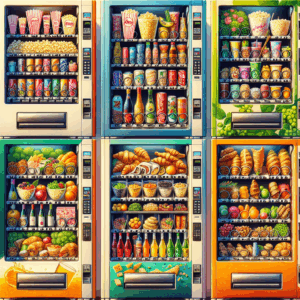Understanding Audience Needs and Behavior
Researching Your Demographic
Before diving into placement logistics, it’s crucial to know your audience. I always start by gathering data about the typical users of the area where I plan to place a vending machine. Who are they? What do they crave? Is it snack attacks in an office or energy recharges in a gym? Each location has a distinct set of patrons, and the more you understand them, the better your machine will perform.
Once you have your data, you’ve got to interpret it. For instance, if the majority of your audience is health-conscious gym-goers, loading up the machine solely with sugary sodas might not be the best move. Instead, stocking it with sports drinks, protein bars, and water would yield better sales.
Finally, engagement is key. I’ve found that talking directly to people in the area can provide deeper insights. There’s nothing like a good old-fashioned chat to uncover expectations and preferences that surveys alone might miss.
Timing and Traffic Patterns
Let’s talk timing — one of the most overlooked factors in vending machine success. It’s about syncing with the flow of people. A prime time to stock your machine in a busy office might be just before lunch hours or after work when people are rushing for a quick snack.
Observing traffic patterns will also help you decide the best times for maintenance, avoiding any downtime during peak hours. Trust me, nothing frustrates a hungry customer more than a “Temporarily Out of Order” sign staring back at them right when they need a snack or drink.
To get this right, I use simple observation and sometimes set up temporary cameras with permissiom, to track the ebb and flow of foot traffic over a given period. This groundwork pays off by ensuring the machine is allied with peak demand times.
Feedback Loops
Ah, feedback — it’s the gift that keeps on giving. After you’ve set up your machine, the job isn’t quite done. It’s important to establish a regular feedback loop with your audience to continually hone in on their evolving needs. I’m a fan of simple, accessible feedback mechanisms either through a QR code survey on the machine or incorporating a suggestion box in nearby surroundings.
The real magic happens when you act on this feedback. Maybe your clients are asking for more gluten-free options or suggesting a tweak in pricing. Listening and updating your offerings can turn an underwhelming machine into a local favorite.
In my experience, being responsive not only increases sales but can also turn your brand into a trusted go-to in the area. People appreciate businesses that care enough to listen and adapt to their needs, and they express this appreciation with their loyalty.
Consideration of Environmental Factors
Outdoor vs. Indoor Placement
The first choice you face might be deciding between an indoor or outdoor machine. I lean on my local climate knowledge here—outdoor environments need weather-resistant machines with robust security features, while indoors, you may have more leeway in designs and logistics.
An outdoor location sounds great until your machine suffers weather damage. Trust me, the costs can skyrocket quickly from exposure to the elements. Strategically, indoor machines might benefit more due to a controlled climate and protection from vandalism.
Over time, I’ve learned that outdoor machines require investments in upkeep and security. Weigh these costs against the potential sales from unimpeded access to determine if it’s worth it for your specific situation.
Impact of Temperature
Temperature is your friend or foe depending on how you handle it. Place a machine too close to a heat source, and you’ll have a compact sauna that doesn’t sell much. I always recommend positioning the machine away from direct sunlight or heating vents.
Furthermore, keeping refreshments at an inviting temperature is key to hitting those sales. I’ve noticed that people reject products if they’re too warm or oddly cold when they shouldn’t be. It’s these subtle details that make or break a vending machine’s popularity.
Temperature affects restocks too. Chocolates, for instance, require a cooler environment. Understanding the impact of where and what you stock, depending on location temperatures, will keep finances healthy and sales strong.
Lighting Conditions
Lighting can transform a corner and your sales, and I’ve learned it can be just as crucial as the product stock. Customers naturally gravitate towards well-lit machines. So, maximizing light is a sure way to increase your chances of catching their eye.
Daytime will cover you for a good period, but check how visible the machine is as night approaches. Is there enough ambient light to guide someone to it? Placing it near street lamps or installing dedicated lights is effective.
On top of all this, lighting is also a great deterrent against misuse and vandalism, making it doubly important for placement consideration. It’s one of those factors that throw a protective spotlight on your investment.
Aesthetic and Ergonomic Placement
Blending with Surroundings
Vending machines are no longer just snack dispensers; they’re lifestyle accommodating fixtures. Matching the aesthetics of your machine with its surroundings shows attention to detail and increases the overall appeal.
I remember setting up a machine in an upscale office, integrating similar color pallets and sleek designs actually contributed to the office aesthetic. Little touches like these score points with your clientele, making them feel more at ease while purchasing.
However, standing out through contrasting designs can be equally effective, especially in lively settings like colleges and event spaces. It’s all about knowing where to blend in and where to stand out.
Ergonomic Considerations
Ergonomics isn’t just buzzwordy jargon; it’s key in making sure your machine is user-friendly. The objective is to make every interaction seamless, ensuring that even a quick snack run is pleasant.
Height placement is crucial. Machines that aren’t at a comfortable reach can deter people from purchasing — including both adults and the kid crowd. I always suggest testing different users to ensure the least amount of strain in accessing the machine.
Space around the machine matters as well. There needs to be enough room for users to freely move, particularly for spaces that see a lot of foot traffic. A cramped experience isn’t pleasurable, nor does it encourage repeat use.
Design and Branding
Every vending machine tells a story — and design is the voice. Your machine acts as an extension of your brand, so nailing the look leaves lasting impressions. I prioritize a unique touch in design that speaks to the intended audience of the machine.
Effective design caters to both aesthetic appeal and functional clarity. Does the machine easily communicate how to operate? Is it inviting? Concise instructions and appealing design aspects come together to attract and retain user interest.
I also think about long-term brand consistency. Uniform designs across all installations can engrain branding into people’s minds, connecting the visual with the satisfied refreshment experience.
Maximizing Visibility and Accessibility
Strategic Location Selection
Visibility is your golden ticket in vending machine placement. Ask yourself, can customers see the machine as they approach? Understanding the layout of the space ensures you choose its optimal spot.
High-footfall areas like entrance lobbies or frequently used hallways are solid choices. Consistent exposure ensures that the machine remains top-of-mind, aiding spontaneous purchases and increasing sales.
Think of walkways and sightlines, keeping obstructions minimal. Trust me, visually accessible machines that don’t blend into background noise draw in more customers and business opportunities.
Easy Access Infrastructure
Nobody likes a complicated snack retrieval journey. Accessibility refers to every corner of interaction with the machine. It’s vital to ensure the placement doesn’t restrict anyone’s reach.
To avoid barriers, I prefer that there’s enough area around the machine so that users can effortlessly access it. Avoid cramped spaces or places where people are likely to get bottlenecked during peak hours.
And don’t neglect accessibility for all — consider providing consideration for the differently-abled, keeping controls within comfortable reach, and ensuring access paths are unobstructed.
Sales-Driven Visibility Enhancements
Sometimes, a bit of extra emphasis is needed to catch the wandering eye. Add a little flair to make your machine stand out. I’ve used electronic, eye-catching displays that showcase featured products or offers.
Promotional materials or limited-time discounts can boost engagement at just a glance. It’s these clever visibility enhancements that often nudge users into spontaneous purchases.
But remember, balance is key. Too many promotions can clutter the look and dilute the message you’re sending. Keep it smart, keep it impactful, and watch how your machine commands attention.
FAQ
What are the most important factors in vending machine placement?
In my experience, key factors include understanding audience needs, regarding environmental conditions, strategic and ergonomic placement, and ensuring high visibility and accessibility.
Why is audience understanding crucial for vending machine placement?
Knowing your audience allows you to stock products they’ll actually buy and place the machine where it’s most useful. This aligns with local demand, boosting satisfaction and sales.
How do environmental factors impact vending machine performance?
Environmental factors like weather conditions and placement lighting profoundly affect machine durability and purchase inclination. Managing these enhances machine longevity and attractiveness.
What are some common placement blunders to avoid?
Common errors include ignoring audience preferences, neglecting environmental conditions, poor ergonomics, inadequate visibility, and restricting accessibility. Avoiding these can lead to better ROI.



